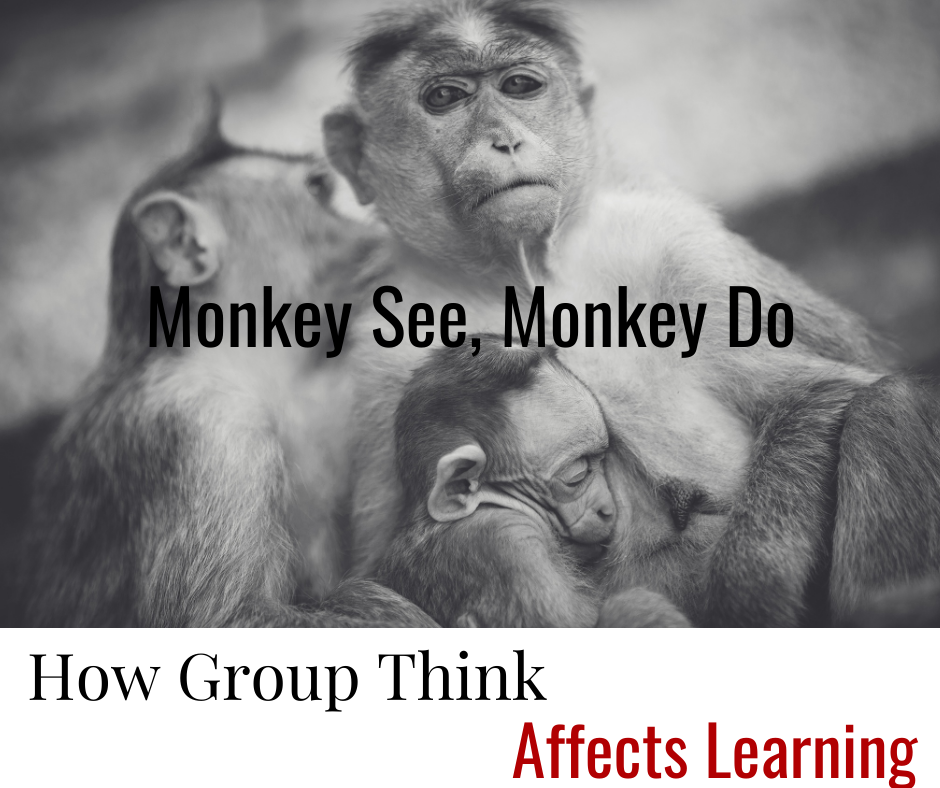As I was driving home today, I listened to an interview with Jonah Berger on WNYC about his new book entitled Invisible Influence: The Hidden Forces that Shape Behavior. It fascinated me, and I could see a direct correlation between his study and my work as a teacher although he did not explicitly discuss education.
In his new book, he explores how people are influenced by group think—how we either go along with the crowd, or go against it—but in one way or another, we are influenced by those around us. He talked about how monkeys that have been relocated will adapt to their new cultural surroundings—much like an American who might call a soda by another name such as “pop” might change terminology if he/she moved to a different region of the country.
Berger differentiates peer “influence” from peer “pressure” because with peer “pressure,” he explains that it sounds as though a group of people is consciously attempting to convince a person to do something whereas peer “influence” is invisible—there is no overt attempt to convince another person—but this invisible power is incredibly strong. Berger argues that group think alters everything about our choices from what we eat, to how we dress, to the careers we choose = every aspect of life.
So, what could this possibly have to do with education?
As a high school teacher who has taught across all levels in grades 9-12, I have witnessed the power of “invisible influence” in my own classroom—we all have. When one student raises a hand, several others do as well. When one student wants to read a certain book, so do several other students.
But let me give you a concrete example of how powerful “invisible influence” can be within the classroom. Last year, I taught three Honors 10th grade English classes, and even though these students were all classified as “Honors” students, one of these classes consistently scored lower than the other two classes of students on major exams, standardized tests, and other benchmarks. I also began to notice that this class had way lower participation on a daily basis, so I began to modify my Honors coursework to meet the needs of this class that was very different than my other two classes of Honors students. In the other two classes, students were discussing the material at college level with a very high rate of class participation, and I was continually impressed with how deep they were consistently taking their analysis of the material.
I began to wonder why there was such a vast difference among the performance of students in these three classes. One of my students (we will call him “George”), who spent the first semester in the lower-performing class, had a schedule change for athletics at the end of the first semester and was moved into one of the higher-performing classes. George was a mediocre student at best, hardly ever spoke a single word in class, and turned in work that was consistent with that of a “C” student. But that worked for him in the class he was in—no one liked to speak, and so he rose to the expectations of that group. When he moved into the other class, however, remaining silent no longer worked. He was in a new group of peers who were bold enough to address George directly in class discussion. At first, I could tell that George was uncomfortable being put on the spot, but eventually, he rose to the occasion and began interacting with his peers like I had never seen him do before. Not only that, but being surrounded by a group of higher performing affected the quality of his writing because he was receiving higher quality feedback on his writing during peer revision sessions. After the first marking period in the new class, George became a “B” student. BAM! There it was—invisible influence in action.
What did this show me? It showed me that students will rise to the group expectations that surround them, and it’s important to take this into account when grouping students. The class atmosphere has a dramatic impact on student achievement and student efficacy, and it is crucial for us as teachers to take this into consideration in crafting activities that will exercise student strengths. So, how did I help my lower performing class? I videotaped George’s new class having a discussion and showed it to his old class. They were impressed with not only how much the class spoke but how much their former peer, George, contributed. They couldn’t believe it. We turned the lesson into a discussion about how to have higher quality discussions and how to participate in a more meaningful way during class. I can’t say that the class dramatically improved across the board, but it definitely helped.
So, think about “invisible influence” in your classroom when you plan your next lesson and see if you can get it to work in your students’ favor.
I have included a link here to the WNYC interview with Jonah Berger for your listening intrigue.
About the Author
Meredith is the founder and creator of TeachWriting.org and Bespoke ELA. She has taught high school English for 10+ years in Dallas, Chicago, and New York City and holds a M.A. in Literature from Northwestern University. She has always had a connection to the written word-- through songwriting, screenplay writing, and essay writing-- and she enjoys the process of teaching students how to express their ideas. Meredith enjoys life with her husband, daughter, and sweet pups.




